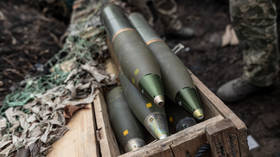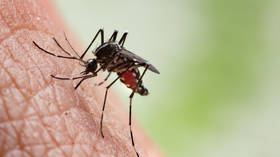Over a dozen CDC workers possibly exposed to Ebola

In yet another safety lab snafu at the Centers for Disease Control and Prevention, as many as a dozen workers are being assessed for possible exposure to the Ebola virus. The incident occurred as a sample of the pathogen was transferred between labs.
CDC officials said Wednesday that one scientist may have been exposed to the Ebola virus, and as many as a dozen others are being assessed for potential exposure at the HQ in Atlanta. Officials said two experienced technicians made mistakes at the high-security lab, known as Biosafety level-4 lab (BSL-4), when material from an Ebola virus experiment was securely transported from the BSL-4 lab to a BSL-2.
That material may have contained a live sample of the virus. If so, that sample should have remained in BSL-4 and should have been stored in a freezer.
READ MORE:Bio-shambles: Over 1,100 pathogen leaks in US labs in 5 years – CDC report
The second mistake came when a BSL-2 lab technician should have recognized, via the color coding on the test tubes, that this material should have stayed at Level 4. That second technician is the person who could have been exposed and is now in the 21-day monitoring period, agency spokeswoman Barbara Reynolds said.
Scientist in Atlanta May Have ... https://t.co/e3IFy7GyCn via @LiveEvents_us#LiveEvents | https://t.co/rx2STCIMvXpic.twitter.com/dEQ1sQg92l
— L'info en temps réél (@Presse24h24) December 25, 2014
The movement between the two labs is significant. In Biosafety level-4 labs, technicians wear one-piece, positive pressure supplied air suits because they are handling dangerous and exotic agents that pose a high level of risk. In Biosafety level-2 labs, in which material is considered moderately hazardous to persons and the environment, technicians wear lab coats, goggles and gloves.
“I am troubled by this incident in our Ebola research laboratory in Atlanta,” said CDC director Tom Frieden in a statement. “We are monitoring the health of one technician who could possibly have been exposed and I have directed that there be a full review of every aspect of the incident and that CDC take all necessary measures.”
“Thousands of laboratory scientists in more than 150 labs throughout CDC have taken extraordinary steps in recent months to improve safety. No risk to staff is acceptable, and our efforts to improve lab safety are essential — the safety of our employees is our highest priority.”
The potential exposure took place Monday and was discovered by scientists on Tuesday, when workers looked in the freezer and saw material that was supposed to be sent down the hall for a genetic analysis. They realized the samples had been switched.
READ MORE:Bio-shambles: Over 1,100 pathogen leaks in US labs in 5 years – CDC report
The technician currently has no symptoms of illness and is being monitored for 21 days. Agency officials said others who entered the lab have been contacted, and based on assessments, it’s likely no one else was exposed. They said the number of people who entered the lab could be as many as a dozen, but was likely far fewer.
Nonetheless, this is the latest in a serious of failures at the CDC. In August, a scientist declined to tell superiors that a worker mixed a lethal strain of bird flu with a more benign one which was shipped out to another laboratory. The dangerous bird flu cocktail was administrated to chickens as part of a US Department of Agriculture study, in which all of the chickens ended up dying.
READ MORE:Lethal bird flu cocktail sent out of lab accidentally, went unreported – CDC
When USDA officials took another look at the sample, they discovered the lethal strain. No people fell ill due to the bird flu strain, the Associated Press reported, but it apparently remained in circulation for months.
In July, a Maryland facility reported that more than 300 vials containing influenza, dengue, and other pathogens were discovered in an unused storage room. And in June, 80 CDC employees were exposed to live anthrax during the transportation of samples from one lab to another. That revelation led to a House Oversight Committee hearing over the CDC’s adherence to safety protocol measures.












